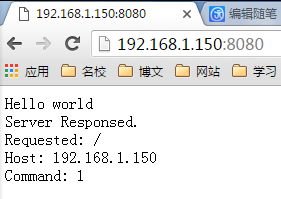檢查Libevent支持的IO復用方法
int main(int argc, char **argv) {// 版本信息cout << event_get_version() << endl;// 所支持的IO復用方法const char **methods = event_get_supported_methods();for (int i = 0; methods[i] != NULL; i++) {cout << methods[i] << endl;}return 0; }
輸出結果為:(Centos7 Clion 2016.1.3環境)

event_get_supported_methods()函數返回Libevent支持的IO復用方法名稱數組,以NULL結尾。該函數實際返回的是全局變量eventops數組,eventops數組存放的是所有支持的IO復用函數,eventops聲明部分的代碼如下:
/* Array of backends in order of preference. */ /* Libevent通過遍歷eventops數組來選擇其后端IO復用技術,遍歷的順序是從數組的第一個元素開始,* 到最后一個元素結束。Linux系統下,默認選擇的后端IO復用技術是epoll。*/ static const struct eventop *eventops[] = { #ifdef _EVENT_HAVE_EVENT_PORTS&evportops, #endif #ifdef _EVENT_HAVE_WORKING_KQUEUE&kqops, #endif #ifdef _EVENT_HAVE_EPOLL&epollops, #endif #ifdef _EVENT_HAVE_DEVPOLL&devpollops, #endif #ifdef _EVENT_HAVE_POLL&pollops, #endif #ifdef _EVENT_HAVE_SELECT&selectops, #endif #ifdef WIN32&win32ops, #endifNULL };
Libevent是如何打日志的
void log(const char *fmt, ...) {char buff[512];va_list ap;va_start(ap, fmt);int len = vsnprintf(buff, sizeof(buff), fmt, ap);buff[len] = '\0';va_end(ap);cout << buff << endl; }
- va_start:宏定義,引用最后一個固定參數所以它能夠對可變參數進行定位。
- va_end:宏定義,函數返回之前一定要調用va_end,這是因為某些實現在函數返回之前需要調整控制信息。
log("hi, are you %s?", "luxon28"); log("name=%s, age=%d", "luoxn28", 23);

更多va_start/va_end信息請點擊:http://www.cnblogs.com/hanyonglu/archive/2011/05/07/2039916.html。
定時器的使用
#include <iostream>#include <event.h> #include <event2/http.h>using namespace std;// Time callback function void onTime(int sock, short event, void *arg) {static int cnt = 0;cout << "Game Over! " << cnt++ << endl;struct timeval tv;tv.tv_sec = 1;tv.tv_usec = 0;if (cnt < 5) {// Add timer eventevent_add((struct event *) arg, &tv);}else {cout << "onTime is over" << endl;} }int main(int argc, char **argv) {cout << event_get_version() << endl;struct event_base *base = event_init();struct event ev;evtimer_set(&ev, onTime, &ev);struct timeval timeevent;timeevent.tv_sec = 1;timeevent.tv_usec = 0;event_add(&ev, &timeevent);// Start event loopevent_base_dispatch(base);event_base_free(base);return 0; }
輸出結果如下:

LZ安裝的是Libevent版本是2.0版本,event_init()函數初始化一個事件類結構體,其中已經選擇好了IO復用函數,比如Linux下一般是epoll;初始化了一個事件活動隊列,當事件發生時,會被加入到該事件活動隊列中,然后統一執行事件活動隊列中的所有事件(也就是調用對應的回調函數)。event_base結構體詳細內容如下:
/* 結構體event_base是Libevent的Reactor */ struct event_base {/* 初始化Reactor時選擇的一種后端IO復用機制,并記錄在如下字段中 */const struct eventop *evsel;/* 指向IO復用機制真正存儲的數據,它通過evsel成員的init函數來進行初始化 */void *evbase;/* 事件變化隊列,其用途是:如果一個文件描述符上注冊的事件被多次修改,則可以使用緩沖區來避免重復的* 系統調用(比如epoll_wait)。它僅能用于時間復雜度為O(1)的IO復用技術 */struct event_changelist changelist;/* 指向信號的后端處理機制,目前僅在singal.h文件中定義了一種處理方法 */const struct eventop *evsigsel;/* 信號事件處理器使用的數據結構,其中封裝了一個由socketpair創建的管道。它用于信號處理函數和* 事件多路分發器之間的通信 */struct evsig_info sig;/* 以下3個成員是添加到該event_base的虛擬事件、所有事件和激活事件的數量 */int virtual_event_count;int event_count;int event_count_active;/* 是否執行完活動事件隊列上的剩余的任務之后就退出事件處理 */int event_gotterm;/* 是否立即退出事件循環,而不管是否還有任務需要處理 */int event_break;/* 是否應該啟動一個新的事件循環 */int event_continue;/* 目前正在處理的活動事件隊列的優先級 */int event_running_priority;/* 事件循環是否啟動 */int running_loop;/* 活動事件隊列數組,索引值越小的隊列,優先級越高。高優先級的活動事件隊列中的事件處理器將被優先處理 */struct event_list *activequeues;/* 活動事件隊列數組的大小,即該event_base共有nactivequeues個不同優先級的活動事件隊列 */int nactivequeues;/* common timeout logic *//* 以下3個成員用于管理通用定時器隊列 */struct common_timeout_list **common_timeout_queues;int n_common_timeouts;int n_common_timeouts_allocated;/* 存放延時回調函數的鏈表,事件循環每次成功處理完一個活動事件隊列中的所有事件之后,* 就調用一次延遲回調函數 */struct deferred_cb_queue defer_queue;/* 文件描述符和IO事件之間的映射關系表 */struct event_io_map io;/* 信號值和信號事件之間的映射關系表 */struct event_signal_map sigmap;/* 注冊事件隊列,存放IO事件處理器和信號事件處理器 */struct event_list eventqueue;struct timeval event_tv;/* 時間堆 */struct min_heap timeheap;struct timeval tv_cache;#if defined(_EVENT_HAVE_CLOCK_GETTIME) && defined(CLOCK_MONOTONIC)/** Difference between internal time (maybe from clock_gettime) and* gettimeofday. */struct timeval tv_clock_diff;/** Second in which we last updated tv_clock_diff, in monotonic time. */time_t last_updated_clock_diff; #endif/* 多線程支持 */ #ifndef _EVENT_DISABLE_THREAD_SUPPORT/* threading support *//** The thread currently running the event_loop for this base *//* 當前運行該event_base的事件循環的線程 */unsigned long th_owner_id;/** A lock to prevent conflicting accesses to this event_base */void *th_base_lock; /* 鎖變量 *//** The event whose callback is executing right now *//* 當前事件循環正在執行哪個事件處理器的回調函數 */struct event *current_event;/** A condition that gets signalled when we're done processing an* event with waiters on it. *//* 條件變量,用于喚醒正在等待某個事件處理完畢的線程 */void *current_event_cond;/** Number of threads blocking on current_event_cond. */int current_event_waiters; /* 等待current_event_cond的線程數 */ #endif/** Flags that this base was configured with *//* 該vent_base的一些配置參數 */enum event_base_config_flag flags;/* 下面這些成員變量給工作線程喚醒主線程提供了方法(使用socketpair創建的管道) *//* Notify main thread to wake up break, etc. *//** True if the base already has a pending notify, and we don't need* to add any more. */int is_notify_pending;/** A socketpair used by some th_notify functions to wake up the main* thread. */evutil_socket_t th_notify_fd[2];/** An event used by some th_notify functions to wake up the main* thread. */struct event th_notify;/** A function used to wake up the main thread from another thread. */int (*th_notify_fn)(struct event_base *base); }
event_add()函數是往事件結構體中加入監聽的一個事件,這里是定時事件,當定時事件到時,就會執行對應的回調函數。event_base_dispatch()函數開始執行事件監聽,對應于epoll的話也就是調用epoll_wait了。最后,當程序執行完畢后,需要調用event_base_free()函數來執行資源的銷毀操作,至此,整個定時器事件就執行完畢了。
?
簡單的HTTP服務器
使用Libevent,我們可以用不超過50行代碼實現一個簡單的HTTP服務器程序,沒有聽錯,就是幾十行代碼,不像Java那樣,需要配置Tomcat,然后編寫對應的Servet,配置web.xml等等(如果使用SSM或者SSH的話步驟或許更多一點呦 :( )。下面就是一個簡單的HTTP服務器示例代碼:
#include <iostream>#include <event2/event.h> #include <event2/buffer.h> #include <event2/http.h>using namespace std;#define INFO 1 #define ERR 3 static void log(int level, string info) {switch (level) {case INFO:cout << "[info] tid[" << pthread_self() << "]: " << info << endl;break;case ERR:cout << "[err] tid[" << pthread_self() << "]: " << info << endl;break;default:break;} }/*** http callback function*/ void httpHandler(struct evhttp_request *request, void *arg) {struct evbuffer *buff = evbuffer_new();if (!buff) {log(INFO, "evbuffer_new error");return;}evbuffer_add_printf(buff, "Hello world</br>");evbuffer_add_printf(buff, "Server Responsed.</br> Requested: %s<br/>", evhttp_request_get_uri(request));evbuffer_add_printf(buff, " Host: %s<br/>", evhttp_request_get_host(request));evbuffer_add_printf(buff, " Command: %d", evhttp_request_get_command(request));evhttp_send_reply(request, HTTP_OK, "OK", buff);evbuffer_free(buff); }int main(int argc, char **argv) {struct event_base *base = event_base_new();struct evhttp *httpServer = evhttp_new(base);int result = evhttp_bind_socket(httpServer, NULL, 8080);if (result != 0) {log(ERR, "evhttp_bind_socket error");return -1;}/* 這是http回調函數 */evhttp_set_gencb(httpServer, httpHandler, NULL);cout << "Http server start OK..." << endl;event_base_dispatch(base);evhttp_free(httpServer);event_base_free(base);return 0; }
訪問頁面如下,192.168.1.150主機是linux服務器。

看到這里,學習Java Web的小伙伴是不是覺得很熟悉,沒錯,就是像Servlet。LZ個人覺得,對于小型程序來說,使用C/C++的網絡庫編程程序更爽一點,因為更加"接地氣?"一點,也就操作起來更加靈活,使用Java的話肯定要使用Servet容器了,比如Tomcat或者Jboss等,然后各種配置等。但是對于動態Web技術來說,使用Java更爽一點。




)
...)











)

